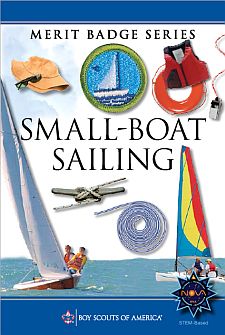- Do the following:
- Explain to your counselor the most likely hazards you may encounter while participating in small-boat activities, and what you should do to anticipate, help prevent, mitigate, and respond to these hazards.
- Review prevention, symptoms, and first-aid treatment for the following injuries or illnesses that can occur while sailing: blisters, cold-water shock and hypothermia, dehydration, heat-related illnesses, sunburn, sprains, and strains.
- Discuss the BSA Safety Afloat policy. Tell how it applies to small-boat activities.
- Before doing requirements 3 through 9, successfully complete the
BSA swimmer test:
- Jump feetfirst into water over the head in depth. Level off and swim 75 yards in a strong manner using one or more of the following strokes: sidestroke, breaststroke, trudgen, or crawl; then swim 25 yards using an easy resting backstroke. The 100 yards must be completed in one swim without stops and must include at least one sharp turn. After completing the swim, rest by floating.
- Describe the boat you will be using for the sailing requirement, naming all of the major parts and the function of those parts.*
- Before going afloat, do the following:
- Discuss the nine points of the BSA Safety Afloat plan.
- Explain the rules of the road in general and any specific rules or laws that apply to your area or state.
- Explain how water conditions, the hazards of weather, and heavy winds can affect both- safety and performance in sailing.
- Discuss the warning signs of inclement weather and what to do should heavy winds develop or a storm approach.
- Prepare a typical float plan.
- Discuss the proper clothing, footwear, and personal gear required for small-boat sailing in warm weather and in cool weather. Explain how choosing the proper clothing, footwear, and personal gear will .help keep you comfortable and safe while sailing.
- Discuss with your counselor how to identify the wind direction and wind indicators. Explain the importance of this task before setting sail.
- Following the BSA Safety Afloat plan, show that you and a buddy
can sail a boat properly. Do the following:
- Prepare a boat for sailing, including a safety inspection.
- Get underway from a dock,. mooring, or beach.
- Properly set sails for a round-trip course approved by your counselor that will include running, beating, and reaching-the basic points of sail. While sailing, demonstrate good helmsmanship skills.
- Change direction by tacking; change direction by jibing.
- Demonstrate getting out of irons.
- Demonstrate the safety position.
- Demonstrate capsize procedures and. the rescue of a person overboard.§
- Demonstrate the procedure to take after running aground.
- Accept a single line or side tow and maneuver the craft being towed safely for 20 boat lengths.
- Upon returning to the dock, mooring, or beach, properly secure all equipment, furl or stow sails, and prepare the craft for unattended docking or beaching overnight or longer.
- Demonstrate a working knowledge of marlinespike seamanship. Do the
following:
- Show how to tie a square (reef) knot, clove hitch, two half hitches, bowline, cleat hitch, and figure-eight knot. Demonstrate the use of each.
- Show how to heave a line, coil a line, and fake down a line.
- Discuss the kinds of lines used on sailboats and the types of fibers used in their manufacture. Explain the advantages and disadvantages of each.
- Describe how you would care for and maintain a sailboat and its gear throughout the year.
- With your counselor, review sailing terminology and the points of sail. Discuss various types of sailboats in use today and explain their differences.
*The skill demonstrated on any boat available to the Scout; sailboards are not acceptable. While no specific sail plan is recommended, it is suggested that the craft be smaller than 20 feet. The boat must be capsizable and have the capability of sailing to windward.
§ Capsize procedures should be conducted under the close supervision of the counselor. A rescue boat should be standing by to assist, if necessary, and to tow the capsized craft to shore. Self-bailing boats are acceptable for this requirement. Extreme care should be taken to avoid personal injury and damage to the boat or equipment.
Note to the Merit Badge Counselor:
In the 2021 Guide to Advancement (BSA Publication 33088 - SKU 648216), Under Section 7.0.1.0 Merit Badge Counseling Risk Management and Quality Control - Section 7.0.1.1 Supervisory Qualifications and Certifications has specific special qualifications or certifications for either the merit badge counselor or the supervisor of certain activities that may be involved with this merit badge, as follows:
The qualifications below for aquatics-related merit badge counseling and supervision not only assist in managing risk, but also give counselors credibility. Current policies are found at Guide to Safe Scouting at www.scouting.org/ health-and-safety/gss/gss02 and supersede any other publications or literature.
Small Boat Sailing. Those supervising sailing activities must have completed Safety Afloat training. They must be mature and conscientious adults age 21 or older. Appropriate credentials indude instructor certification with a recognized sailing agency or school, US Sailing, or the American Sailing Association for sailing experience with different hull types including the rig being used for instruction; OR local councils may approve individuals previously certified as such, or trained by an instructor so qualified.
BSA Advancement ID#:
105
Scoutbook ID#:
109
Requirements last updated in:
2023
Pamphlet Publication Number:
35950
Pamphlet Stock (SKU) Number:
649749
E-Book Stock (SKU) Number:
656090
Pamphlet Copyright Date:
2016
|
|||||||
Page updated on: December 22, 2022









